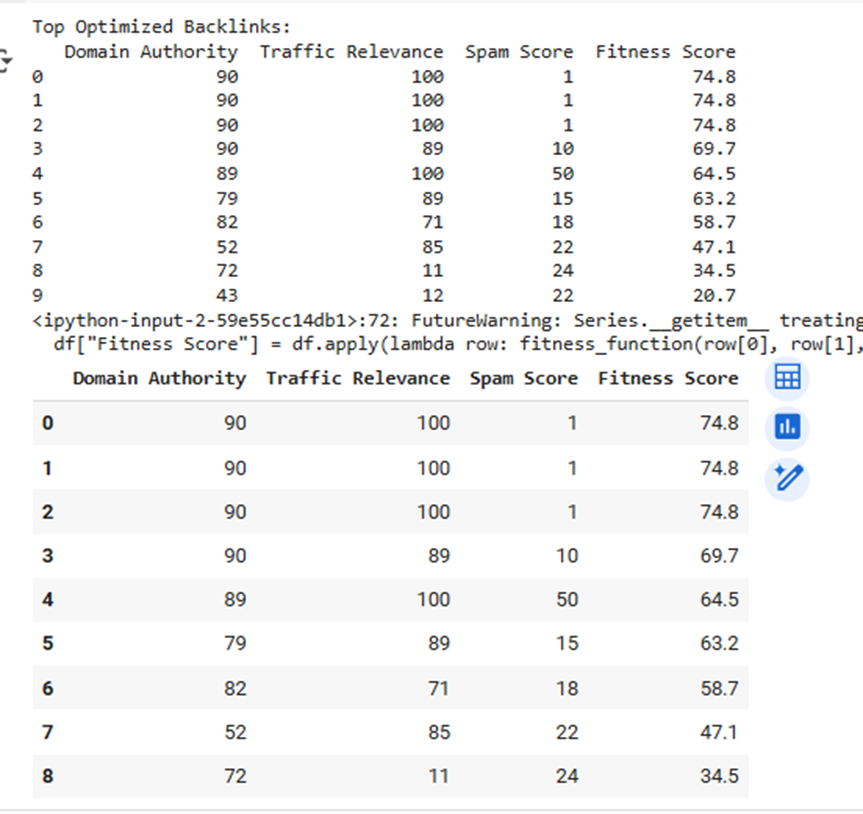SUPERCHARGE YOUR ONLINE VISIBILITY! CONTACT US AND LET’S ACHIEVE EXCELLENCE TOGETHER!
Link Analysis & Link-Building Strategy
Use Case: Identifying the Best Backlink Opportunities
- Application:
- CSA can be used to identify high-authority link-building opportunities by evaluating domain authority, traffic potential, and relevance.It can optimize internal linking structures for better link equity distribution.
- CSA can help predict which backlinks will provide the most SEO value based on historical data.
- How CSA Works:
- Each potential backlink is an “egg” (solution).
- The algorithm evaluates the quality of each backlink based on DA, spam score, traffic potential, and relevance.
- Poor-quality backlinks are discarded, and new potential links are explored.
- The final output suggests the most valuable backlinking opportunities for SEO growth.

Here is the detailed implementation algorithm,
Step 1: Gather Potential Backlink Sources
- Use tools like Ahrefs, SEMrush, Moz to generate a list of backlink opportunities.
- Collect data for each link:
- Domain Authority (DA)
- Traffic relevance
- Spam score
- Anchor text relevance
Step 2: Define the Fitness Function
Fitness=0.5×(DA)+0.3×(TrafficRelevance)−0.2×(SpamScore)Fitness = 0.5 \times (DA) + 0.3 \times (Traffic Relevance) – 0.2 \times (Spam Score)Fitness=0.5×(DA)+0.3×(TrafficRelevance)−0.2×(SpamScore)
- High DA and relevance increase the score.
- High spam score decreases the score.
Step 3: Implement Cuckoo Search
- Each potential backlink is a “cuckoo egg.”
- The algorithm evaluates and selects high-quality links.
- Poor-quality links are replaced with new ones through Lévy flight mutations.
Example python script for the above application:
import numpy as np
import random
import math
import pandas as pd
# Step 1: Simulate Backlink Data (20 backlinks)
np.random.seed(42)
num_backlinks = 20 # Number of backlink opportunities
backlinks = []
for _ in range(num_backlinks):
DA = np.random.randint(20, 90) # Domain Authority (20-90)
TrafficRelevance = np.random.randint(10, 100) # Traffic relevance (10-100)
SpamScore = np.random.randint(1, 50) # Spam score (1-50)
backlinks.append([DA, TrafficRelevance, SpamScore])
# Step 2: Define Fitness Function
def fitness_function(DA, TrafficRelevance, SpamScore):
return 0.5 * DA + 0.3 * TrafficRelevance – 0.2 * SpamScore
# Step 3: Implement Cuckoo Search Algorithm
# Lévy Flight Function (Fixed)
def levy_flight(Lambda):
sigma = (math.gamma(1 + Lambda) * math.sin(math.pi * Lambda / 2) /
(math.gamma((1 + Lambda) / 2) * Lambda * 2 ** ((Lambda – 1) / 2))) ** (1 / Lambda)
u = np.random.normal(0, sigma, size=1)
v = np.random.normal(0, 1, size=1)
step = u / np.abs(v) ** (1 / Lambda)
return step[0]
# Cuckoo Search Parameters
n = 10 # Number of cuckoo nests
iterations = 100 # Maximum iterations
pa = 0.25 # Discovery rate
# Initialize random nests (backlinks)
nests = random.sample(backlinks, n)
for iteration in range(iterations):
new_nests = []
for nest in nests:
DA, TrafficRelevance, SpamScore = nest
fitness_old = fitness_function(DA, TrafficRelevance, SpamScore)
# Generate new solution with Lévy Flight
step_size = levy_flight(1.5) * (np.array(nest) – np.array(random.choice(nests)))
new_solution = np.array(nest) + step_size
new_solution = np.clip(new_solution, [20, 10, 1], [90, 100, 50]) # Keep values within range
DA_new, TrafficRelevance_new, SpamScore_new = new_solution.astype(int)
fitness_new = fitness_function(DA_new, TrafficRelevance_new, SpamScore_new)
# Replace if new solution is better
if fitness_new > fitness_old:
new_nests.append([DA_new, TrafficRelevance_new, SpamScore_new])
else:
new_nests.append(nest)
# Abandon poor nests and introduce new random ones
for i in range(int(pa * n)):
new_nests[random.randint(0, n – 1)] = random.choice(backlinks)
nests = new_nests # Update nests
# Select top backlinks based on fitness
best_backlinks = sorted(nests, key=lambda x: fitness_function(*x), reverse=True)
# Display the best backlink opportunities
df = pd.DataFrame(best_backlinks, columns=[“Domain Authority”, “Traffic Relevance”, “Spam Score”])
df[“Fitness Score”] = df.apply(lambda row: fitness_function(row[0], row[1], row[2]), axis=1)
print(“Top Optimized Backlinks:”)
print(df)
# Display table in Google Colab
from IPython.display import display
display(df)
Output Example:

Note: the above code is just an example, it does not provide accurate result. It needs to optimize with real facts and data like complete backlink metrics form any trusted tool.
Collab Experiment Link:
https://colab.research.google.com/drive/13DJU6-iVfuHwPlTv3UUcHc_QgjyNxDiI

Thatware | Founder & CEO
Tuhin is recognized across the globe for his vision to revolutionize digital transformation industry with the help of cutting-edge technology. He won bronze for India at the Stevie Awards USA as well as winning the India Business Awards, India Technology Award, Top 100 influential tech leaders from Analytics Insights, Clutch Global Front runner in digital marketing, founder of the fastest growing company in Asia by The CEO Magazine and is a TEDx speaker and BrightonSEO speaker.

